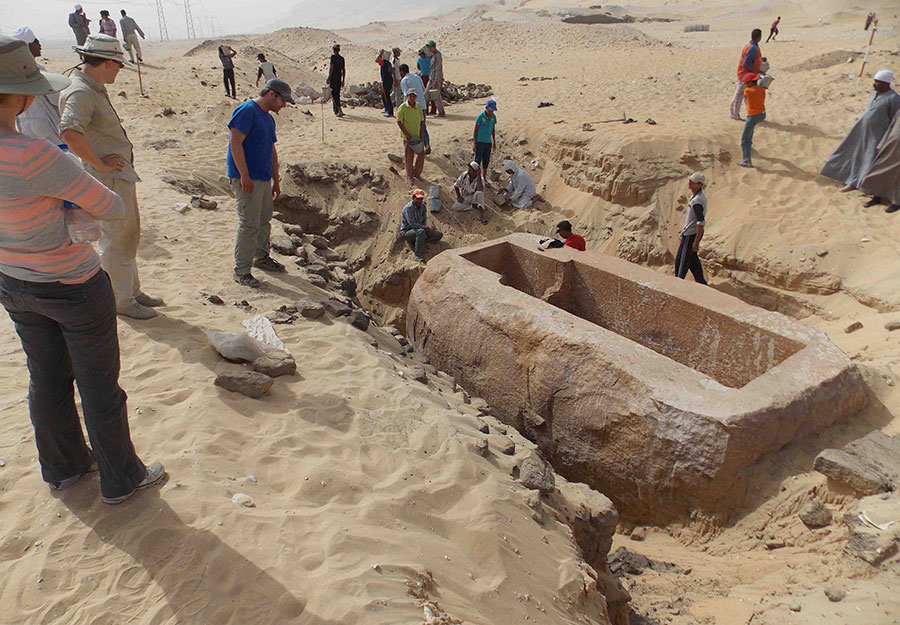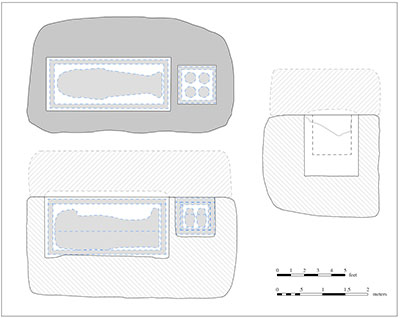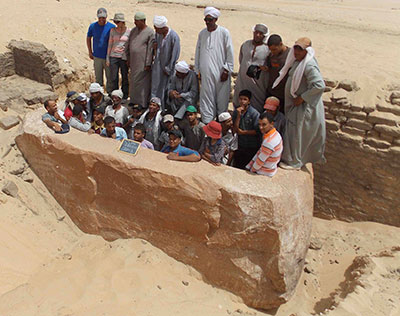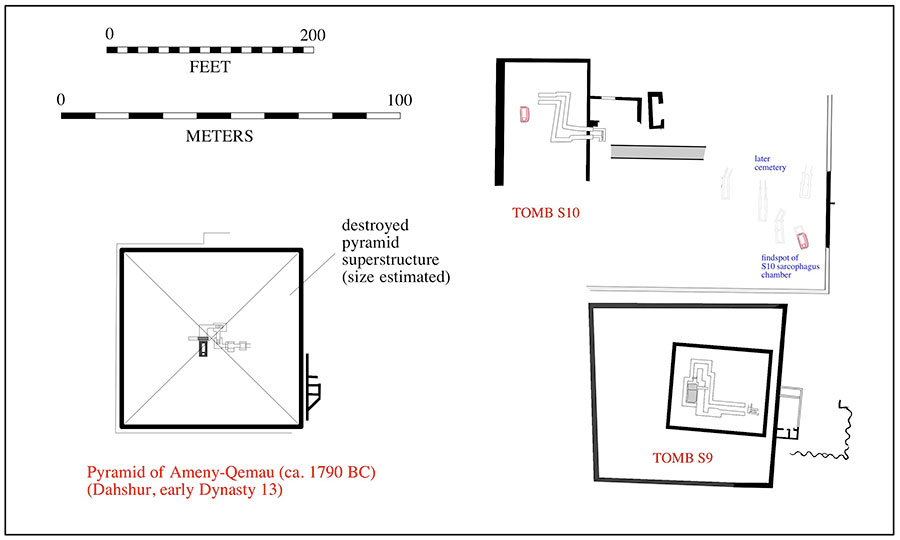
During June 2013, excavations were underway near the base of the Mountain-of-Anubis. The search was on for private cemeteries belonging to the Middle Kingdom community of Wah-sut. Excavations since 1994 have revealed a large and complex settlement site. But where are the tombs of the thousands of people who must have lived and died at South Abydos ca. 1850–1650 BCE?
Kevin Cahail has been investigating that issue for his dissertation research and we were excavating a group of tombs near the base of Mountain-of-Anubis that looked like promising candidates for Middle Kingdom burials. These had appeared in magnetic mapping, sandwiched between two huge,ruined royal tombs: Tomb S9 and Tomb S10 that Arthur Weigall had first examined in 1901–1902. What emerged from the ground last summer was a series of well-made tombs with vaulted chambers, each descending to a stonelined burial chamber. Stripped clean by ancient tomb robbers, the structures are difficult to date precisely.
Strangely enough, however, there was something Middle Kingdom in these tombs. One of them had departed from the normal format and made use of a massive, monolithic sarcophagus chamber. Over the top of this stone chamber, which is sunk about four feet into the desert sand, a roughly constructed brick vault and access shaft had once been fitted. The stone chamber, however, is not original to the location; it is a reused royal sarcophagus chamber.
As the sarcophagus chamber slowly emerged from the sand we were astounded by its size. Measuring 16 feet long, 7 feet wide, and 7.5 feet high, the block weighs about 60 tons. The chamber’s form was quickly apparent: it is a distinctive Late Middle Kingdom sarcophagus chamber of a type that first developed in the late 12th Dynasty during the reign of Senwosret III’s successor, Amenemhat III. Formed out of a single block into which recesses were cut for the royal coin and the canopic chest, the block would originally have been covered by an equally massive lid that was lowered to seal the royal burial. What was this royal sarcophagus chamber doing here adrift in the desert sands? Exactly the same form of chamber with lid (composed of two blocks) still exists in situ in the well-preserved interior architecture of Tomb S9. Dawn McCormack reached the lid of that chamber in 2002 (for a photo of that lid see Expedition 48.2 [2006]: 25). In his brief description of the examination of nearby Tomb S10 Weigall stated that he found only the lid of the sarcophagus chamber, which was “a large sized block, carefully dressed on all sides.” The burial chamber of this badly destroyed royal tomb had been removed. It was quickly apparent that in 2013 we had discovered the missing sarcophagus chamber from Tomb S10, reused in a later tomb just a few hundred feet from its original location.
An Impressive Engineering Achievement


The sarcophagus is a massive piece of red-purple quartzite. The upper surface and interior is finely dressed and smooth. Cut into the block is a rectangular recess measuring 9 feet long, 4 feet wide, and 4.3 feet deep. this would have housed the royal burial—probably a series of nested anthropoid coins within a rectangular wooden coin that was then lowered into the receptacle. Adjoining the coin recess, at what would be the foot end of the chamber, is a cubical recess measuring 2.8 feet on all sides for the canopic box. 5e chamber’s outside faces were left roughly dressed since that part would originally have been set deep within the substructure of Tomb S10. the chamber’s massive lid—still buried within Tomb S10—should have had a vaulted interior and sealed both recesses.
An important insight into this chamber has resulted from microscopic examination of the quartzite stone from which the chamber is cut. Quartzite occurs in only two areas of Egypt: at Aswan, 150 miles south of Abydos, and at the Gebel Ahmar (the “red-mountain”) well over 300 miles to the north and just east of modern Cairo. Upon seeing this massive quartzite chamber, our first assumption was that the stone probably originated at the closer Aswan quartzite quarries. Stone quarried from Aswan could have been floated down the Nile to Abydos following the river’s current. However, microscopic examination proved otherwise. The quartz grains that make up the stone’s matrix fall between rounded and subangular. Furthermore, a small fragment exhibited chert inclusions within the matrix. Comparing these results to studies on the stones of Gebel Ahmar and Aswan, we have concluded that the S10 sarcophagus chamber quartzite originated in the Gebel Ahmar quarries. To reach Abydos the sarcophagus had to journey well over 300 miles upstream from the quarry site—an indication of the wealth and investment that went into Tomb S10.
Most modern observers stand in awe of the engineering and fabrication abilities of the ancient Egyptians, especially in their ability to work hard stone. The S10 sarcophagus chamber is no exception. Its top is almost perfectly 8at. Of the four internal corners of the large sarcophagus portion of the chamber, two are a perfect 90°, and the other two are an almost-perfect 89.5°. The cutting of the interior was achieved with hand-twisted drills and finished with stone grinders. Experimental archaeology has reproduced the rate of work and demonstrates that the S10 chamber would have taken several years to complete and transport to Abydos. However one looks at it, the process of quarrying, carving, and moving the S10 sarcophagus chamber was an impressive engineering achievement, fit for a royal tomb.
The Ownership of the Royal Sarcophagus Chamber
Who was the original owner of this huge sarcophagus chamber? 5is question is connected with the significance of the Mountain-of-Anubis for pharaohs who succeeded Senwosret III. Based on the architecture of the two satellite tombs, which Weigall first examined a century ago, these tombs may belong to 13th Dynasty pharaohs who chose to locate their tombs near that of Senwosret III for political and religious reasons. Dawn McCormack has examined this possibility and suggests that a specific group of 13th Dynasty kings used the location as a way of symbolically legitimizing their rulership; she would like to attribute these tombs to the middle 13th Dynasty kings Neferhotep I, Sahathor, and Sobekhotep IV (dating ca. 1750–1720 BCE).
We have developed different explanations as to the possible identities of the owners of S9 and S10, which may better accommodate the available evidence. In 2004, excavations at the front of the Senwosret III tomb enclosure revealed a set of architectural connections linking the earlier Senwosret III enclosure with the brick enclosure wall that surrounds Tomb S9. Pottery deposits right up against S9’s enclosure wall are typical of the period of transition between the 12th and 13th Dynasties. It appears likely that S9—the closer of the two royal tombs—was built not very long after the initial construction of the Senwosret III tomb enclosure with which it is actually physically connected.
In 2013, we examined the huge volume of smashed limestone fragments that litter the debris mounds of Tomb S10. Many fragments certainly come from the smashed substructure (passages and roofing blocks of the tomb’s interior), but other fragments appear to derive from finely dressed masonry that underwent a signifcant period of weathering—probably stone casing of the tomb’s original superstructure. Blocks with a batter or slope suggest there was once an angled limestone casing to this tomb. 5e superstructure appears likely to have been a pyramid—probably one that was economically built with a debris-filled interior and a finely dressed exterior. 5e later pyramid of Ahmose (ca. 1550 BCE) at Abydos, Egypt’s last royal pyramid, was built in this same way.
At some point the superstructure of Tomb S10 was heavily destroyed and much of the masonry removed resulting in the eventual extraction of the quartzite sarcophagus chamber from its substructure. Although we still lack a positive identification of the owner, the form of the newly discovered sarcophagus chamber paired with what we know of Tombs S9 and S10 furnishes some intriguing possibilities.
Late Middle Kingdom Royal Tombs at Abydos
An important aspect of the ownership of these two royal tombs is the question: why were there two kings (and as far as we know only two) who built royal tombs next to that of Senwosret III? If royal interest had emerged during the 13th Dynasty of establishing links with Senwosret III, it might logically be a practice adopted by more than just a single pair of kings (the 13th Dynasty includes over 50 shortreigning kings dating ca. 1800–1660 BCE). Whoever these two pharaohs were, they appear to be closely linked in time, and probably family identity. Potentially they may have familial connections with Senwosret III himself. familial connections with Senwosret III himself.

Evidence bearing on this question derives from the newly discovered sarcophagus chamber and the results of Weigall’s partial examination of Tomb S10 a hundred years ago. Both S10 and its neighbor S9 are versions of a distinctive form of royal tomb that emerged at the site of Hawara in the Fayum region of Egypt. Hawara was the second pyramid of Amenemhat III, the son and successor of Senwosret III. Its interior is characterized by a circuitous sequence of passages, each blocked by sliding portcullis stones and ending in a monolithic burial chamber. The burial chamber was sealed by a massive lid that was lowered into place from above. The combination of chamber and lid created a practically impenetrable mass of stone in which the royal burial would remain protected from tomb robbers.
The pyramid at Hawara forms the prototype for all of the known late Middle Kingdom royal pyramids. With varying degrees of size and complexity they adopted this same format with the monolithic burial chamber accessed through a sequence of turning passages blocked with portcullis stones. Known examples are not extensive in number but include five pyramids in a cluster at South Dahshur and Mazghuna at the southern end of the Memphite necropolis (four other unexcavated ones lie in the same area). Only two of these can be linked to specific pharaohs. One belongs to king Khendjer of the middle 13th Dynasty. The only other example with a known owner belongs to the early 13th Dynasty king Ameny-Qemau, a pharaoh whose reign of approximately three years falls ca. 1790 BCE, barely a decade after the close of the 12th Dynasty. The similarities in size and design between Ameny-Qemau’s pyramid and Tombs S9 and S10 at Abydos are absolutely striking. The newly found chamber is a virtual carbon copy of that of Ameny-Qemau. Consequently, it appears probable that two pharaohs of the same approximate time period built tombs next to Senwosret III at Abydos. Who were they? The vast majority of the many 13th Dynasty kings did not reign long enough to have constructed tombs on the impressive scale of S9 and S10. Candidates are few. Moreover, we need not limit our consideration to the 13th Dynasty. The period of transition between the 12th and 13th Dynasties provides some good options.
Two of the pharaohs for whom we lack identified tombs are the two final rulers of the 12th Dynasty: Amenemhat IV and the female pharaoh Sobekneferu. Sobekneferu was succeeded by two brother kings, Amenemhat Sobekhotep I and Amenemhat Sonebef. These rulers were sons of Amenemhat IV and their reigns, each about four years, are long enough to have built tombs on the scale of those at South Abydos. Could one of these pharaohs be the owner of S10? If this is the case we may be looking at familial and royal links between these kings and Senwosret III.
Amenemhat IV and Sobekneferu are important transitional pharaohs at the very end of the 12th Dynasty. Together they represent a shift to patterns of kingship that continued during the ensuing 13th Dynasty—short reigning monarchs ruling in the context of a declining economic structure that compromised royal resources for the large-scale monument building that was such a visible product of the earlier 12th Dynasty kings. Amenemhat IV ruled Egypt for some nine years; Sobekneferu for under four years. The death of Sobekneferu (ca. 1797 BCE) brought an end to the 12th Dynasty. While Amenemhat IV and Sobekneferu have often been viewed as a brother-sister pair and children of Amenemhat III, evidence suggests instead that the period may have been characterized by dynastic conflict and problems in the royal succession.
It appears probable that Amenemhat III had no male offspring but at least two daughters: Nefruptah and Sobekneferu. Neferuptah’s name occurs in a royal cartouche, perhaps indicating that she was the chosen successor. Sadly, she predeceased her father. It may have been at that point that Amenemhat III chose a new successor and coregent, Amenemhat IV, a man who appears to have been of nonroyal parentage. Following his death after a nine-year reign, Sobekneferu then seized the throne in place of Amenemhat IV’s own sons. 5rough her short reign, Sobekneferu linked herself with her father Amenemhat III, rather than the previous king Amenemhat IV, perhaps demonstrating her view that she was the rightful successor. After her death (ending the 12th Dynasty), two of Amenemhat IV’s sons, Sobekhotep I and Sonbef, regained the throne. They are the first two kings of the 13th Dynasty.
It makes sense that either Amenemhat IV or Sobekneferu chose to build a tomb at Abydos beside that of Senwosret III. 5e size and design is appropriate to what we might expect from their short reigns and either one may have been interested in connecting themselves with Senwosret III. However, in light of the evidence for dynastic strife at the end of the 12th Dynasty it appears less likely that the pair of tombs together belong to Amenemhat IV and Sobekneferu. Given the close proximity and the similarity of the buildings, as one of the authors of this article, Kevin Cahail, has observed, the two sons of Amenemhat IV—Amenemhat Sobekhotep I and Amenemhat Sonbef—appear to be good candidates.
These two kings were the first rulers of the fledgling 13th Dynasty. Only a few years separates their reigns from that of Ameny-Qemau, whose tomb, as we have seen, is remarkably similar in size and design to S9 and S10. By physically connecting their tombs with the preexisting mortuary cult of Senwosret III at South Abydos, they could have legitimized their rule both politically through the 12th Dynasty royal line, as well as religiously through the cult of Osiris.
Quite possibly the Mountain-of-Anubis includes much more than just the tomb for Senwosret III; it may be an important mortuary and cult site for the final pharaohs of Egypt’s mighty 12th Dynasty and the immediate successors to that royal house: the brother kings Sobekhotep I and Sonbef at the beginning of the 13th Dynasty. In future excavations we will search for clear evidence related to the ownership of these tombs. Systematic excavation of Tombs S9 and S10 should allow us to determine conclusively which pharaohs built these fascinating—but still mysterious—royal tombs that are so intimately linked with that of Senwosret III.
JOSEF WEGNER is Associate Curator of the Egyptian Section at the Penn Museum. He is also Associate Professor of Egyptian Archaeology, Department of Near Eastern Languages and Civilizations, University of Pennsylvania.
KEVIN M. CAHAIL is a Ph.D. candidate in the Department of Near Eastern Languages and Civilizations at the University of Pennsylvania.
